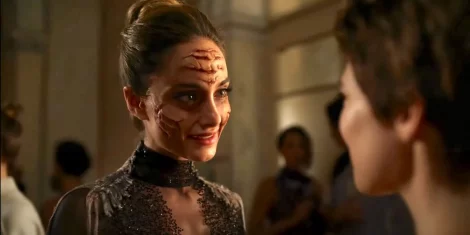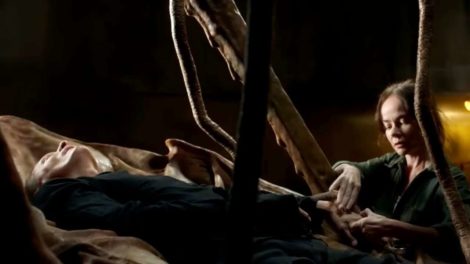Crimes of the Future
Tropic Sprockets by Ian Brockway
[mr_rating_result]David Cronenberg is a director I discovered as a teenager. I was watching “Videodrome” (1983) when the sitter I had a crush on was making out with my friend in front of me. On the TV, James Woods was putting his arm through a television set, while I heard kissing and slurping noises on the sofa. My left eye looked at my friend making out while my right eye glimpsed weird and slightly unnerving images of a deformed arm. Sex was mixed with bodily strangeness.
 As a college student, I saw “Naked Lunch” (1991) with my dad and had to roll past an endless series of elevators, towers of boxes and basement doors. The sense of claustrophobia and disquiet going thru the dark hallway was palpable, a nervous feeling very much like the texture of a Cronenberg film.
As a college student, I saw “Naked Lunch” (1991) with my dad and had to roll past an endless series of elevators, towers of boxes and basement doors. The sense of claustrophobia and disquiet going thru the dark hallway was palpable, a nervous feeling very much like the texture of a Cronenberg film.
Now at 55, I am in front of “Crimes of the Future.” The director has gone back to his origins.
Saul (Viggo Mortenson) is in a dystopian society where no one feels pain. Through evolution (but not thoroughly explained) Saul’s own body is generating new organs, either by chemical interactions, his own brain or the environment.
Saul is a performance artist of sorts who performs surgery on himself with his partner (Lea Seydoux) for crowds of spectators.
Gradually the film develops social commentary by talking about how the earth is overcome by plastic. At the start of the film, it is revealed that a young boy can eat plastic, and digest it where it is used as food via special bodily fluids.
Saul is aging and retires often to a chaise lounge chair in the form of an alien creature which gives him the necessary impetus to eat and sleep.
While the subject matter will isolate many, fans of the director can cheer that Cronenberg is going back to the inspirational material of his youth: body horror.
 The most effective scenes show crowds of people oohing and aahing over various surgical procedures. Then Saul hobbles down a narrow street completely covered in black, his face masked. He looks like a medieval monk or Kafkaesque figure of the apocalypse.
The most effective scenes show crowds of people oohing and aahing over various surgical procedures. Then Saul hobbles down a narrow street completely covered in black, his face masked. He looks like a medieval monk or Kafkaesque figure of the apocalypse.
While the chairs made of actual living creatures are very over the top and come across as comic, the concept of one’s body changing in response to the environment is serious and compelling.
It is true that Cronenberg might have overused “Naked Lunch” here with the frequent alien furniture and stilted dialogue. Still, the director has a tone and a style all of his own. He deserves to be in the company of David Lynch, Jim Jarmusch and John Waters. Like them, Cronenberg is a genuine cinematic artist. One need not understand his content.
The most important aspect is that these films are unique and exclusive. Together they all conjure a complete world that is individual and intense.
Write Ian at ianfree11@yahoo.com


Ratings & Comments
[mr_rating_form]